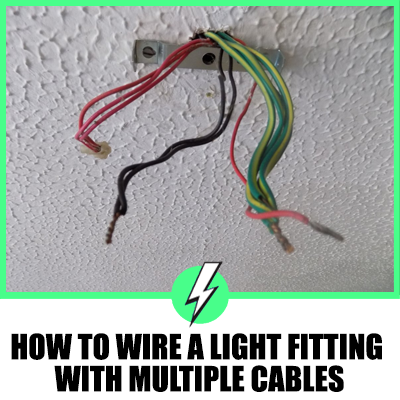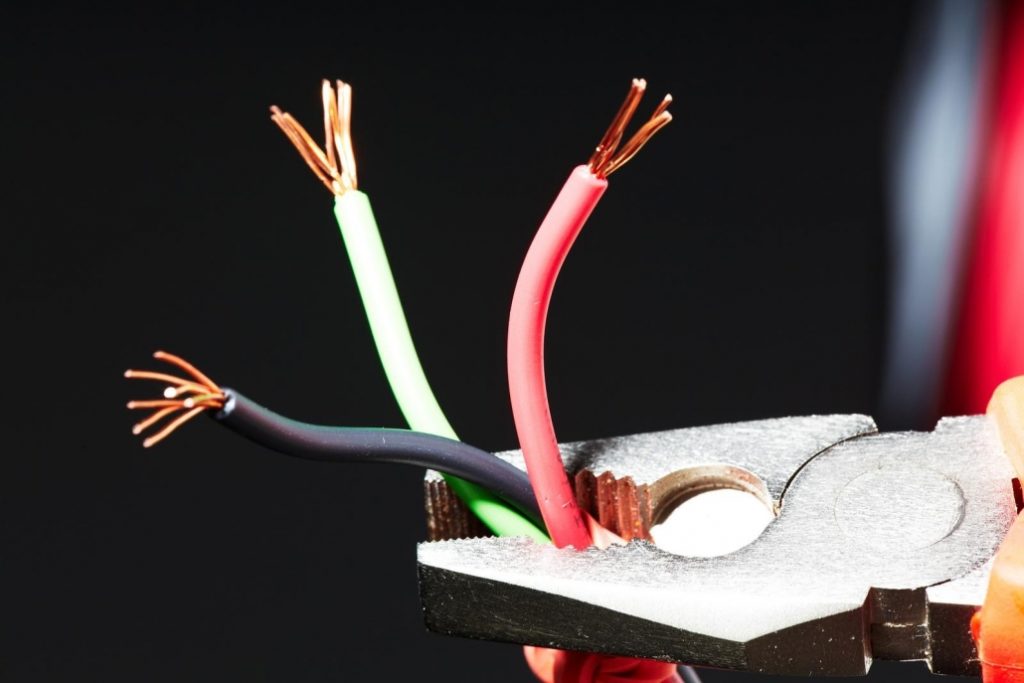How To Wire A Light Fitting With Multiple Cables
Have you ever tried to fit a light fitting only to be confronted with a spaghetti of wires coming from the ceiling? Where do you start?
If you remove the second or third light fitting in the loop, you will face multiple wires hanging from the ceiling. But don’t worry. Once you find out what’s what, it’s all straightforward, and you can easily deal with this daunting task.

Contents
How do you wire a light fixture with two sets of wires?
First, let’s get prepared for the job.
- Safety glasses, it’s easy to get debris in your eyes while looking up at the ceiling
- Insulated 4mm screwdriver
- Insulated side snips
- Insulated wire stripper
- Multimeter
First stage
- Find the consumer unit/fuse box and turn off the circuit. If you are able, turn off the incoming mains power from the red breaker switch.
- From the light fitting, separate the first wires, live (brown) earth (green & brown) and blue the neutral.
- Inside the ceiling rose you are fitting, you can see 4 brass connectors, 1 individual for an earth wire, 3 for neutral, another block of 3 for your loop and a block of 2 for your live feed to the switch. Bring the other feed from the switch and connect it to the loop terminal block.
- Wire the earth to the single connector (if twin and earth use an earth sheath), wire a neutral to the 1 terminal block and a live to the last terminal block of 2, which is going to the live terminal in the switch. Earth the switch and terminate in the rose.
- Connect your pendant light neutral to the neutral terminal block and live to the live terminal block.
- The first circuit is complete.
Second stage
Add the next light to the circuit.
- Use the same ceiling rose to connect the neutral to the new light fixture in the neutral terminal block (the 3 positions are now full). Add the live from the new light fixture in the loop terminal block (3 positions are now full). Add the earth cable into the single shared earth terminal block.
Repeat the same process for every light added to the circuit, except for the switch that will control all of the lights on the ring.
That’s how you wire 9 wires into a single ceiling rose. Remember, if your light fitting is metal, it must be earthed.
How many lights can you put on one switch safely?
On a 15 amp breaker, a single switch can take 30 lights. However, suppose you check in the domestic building services guide. In that case, it is recommended in section 12 of this document on table 42 that “A single switch should operate no more than 6 lights fitting with a maximum of 100 circuit watts”.
What do you do if the cables have been trimmed too short?

It’s quite common to find that there is hardly any room for you to work and make the terminations inside the ceiling rose fitting in some cases.
If this is happening to you, there is a need to worry. You just simply need to extend the wires from the cables.
You can:
- Use crimps, it’s a simple process, but you may be working very close to the ceiling depending on how short the cables are. Crimps provide a good mechanical connection, but they take a little time to fit. You can find different coloured crimps to fit the size of your wire, don’t choose oversize. The crimp will be loose and could potentially cause a short in the circuit
- You can use connector blocks, but if you are tight on space, they can be fiddly to make a solid termination. If you select connector blocks, its standard practice to add insulation taupe to make them more secure
- Solder and heat shrink is time-consuming and the wrong way to tackle this particular job, but it would work. There is always the slight possibility of getting it wrong and causing a fire in the ceiling void
- Wago, by far the easiest method of a speedy solution to the problem, wago’s give a strong mechanical lock onto the conductors and provide a neat solution to tidying up messy wires.
What happens if you wire a light fixture wrong UK?
It will still work if you have wired the light fitting in the wrong sequence. It’s just the wiring is reversed.
It will cause the socket cable to heat up, and if touched, you will run the risk of an electric shock.
If you make a big mistake, the circuit breaker will trip when the circuit is energised; you will need to check your circuit with a multimeter.
What Colours are electrical wires in the UK?
If you are using twin and earth, the outside colour of the cable will be grey. Once you expose the wires inside by peeling back the outer sheath, the live wire will be brown, the neutral wire will be blue, and the earth will be a strand of copper conductor.
When using the earth conductor, you should place an earth sheath over the copper strand for identification and insulation.
What is the common wire UK?
The common wire is the live wire that supplies the input power to the terminals. If you notice an L1 terminal, this is for the output to the light fixture.
What is the purpose of the neutral wire?
The neutral wire (blue) completes the circuit. The neutral carries the power back to the consumer unit, which completes the flow of the electricity.
When the blue neutral connects back to the consumer unit/fuse board, it is either attached to the earth or to the busbar to finalise the circuit and flow of electricity.
Can I get a shock from neutral wire UK?
Yes, the blue neutral is carrying current,m. It is, in this case, part of the daisy chain effect in the circuit or is attaching directly back to your consumer unit/fuse board.





